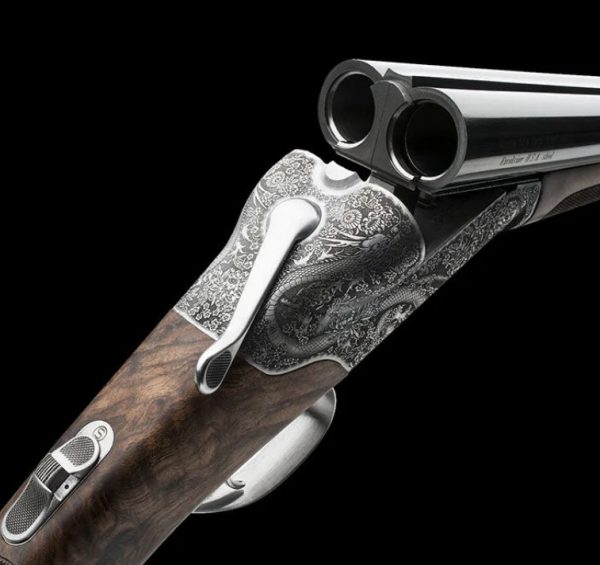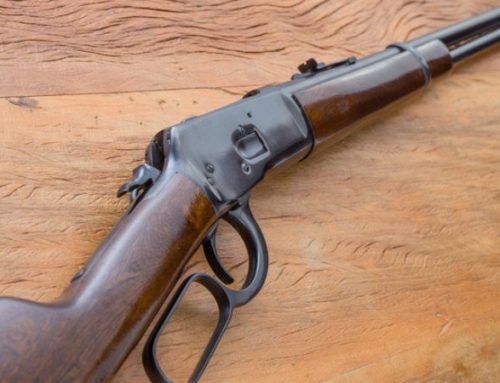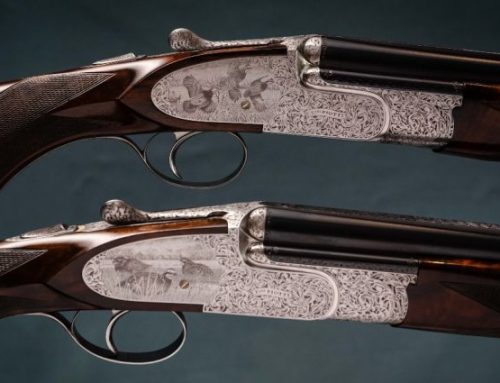In the art of hunting, few aspects are as debated as the choice between a side-by-side (double-barrel) rifle or an over-under (stacked-barrel) rifle. While it’s true that each type of rifle has its advantages, the key to success lies not only in choosing the right tool but, above all, in adapting the technique to make the most of its unique characteristics.
Anyone with experience in both types of rifles knows how different they are in terms of design and use. Every detail, from the weight to the visual plane, profoundly affects how the shot is taken and the strategies employed in the field.
Weight and Recoil: A Matter of Stability
Weight is one of the first differences a hunter will notice. A typical over-under, weighing around 3.2 kg (7 pounds), is generally heavier than a double-barrel, which rarely exceeds 2.7 kg (6 pounds). This extra weight plays a critical role in reducing perceived recoil, especially with medium-power loads like 28g No. 7 shot.

With a double-barrel, recoil is not only more noticeable but follows an “elbow” trajectory: backward and slightly lateral, along the line of the stock, which often has a greater lateral curve compared to an over-under. This results in a greater flip of the muzzle, making shot control more challenging. To counter this effect, it’s advisable to keep the lead arm more extended than with an over-under. A straighter position not only helps absorb recoil with the arm rather than the shoulder, but also improves stability and accuracy, making the rifle almost an extension of your body.
Grips and Control: When the Grip Makes the Difference
The over-under offers clear advantages thanks to its ergonomic stocks. Grips like the “Prince of Wales” or full pistol grips securely lock the hand, offering consistency during mounting, shooting, and follow-through. This design helps distribute recoil through the arms, making the shot smoother and less tiring.

On the other hand, the double-barrel, with its straight stock, requires greater control from the hunter but offers superior maneuverability in tight or quick-moving situations, such as close crossing shots.
The Shooting Technique: Key Differences
The choice of rifle significantly affects shooting technique. With a double-barrel, the most effective approach is instinctive shooting, particularly useful for crossing shots. This technique involves moving the rifle with the bird without completing the mount, aiming ahead of the target, and shooting while maintaining the movement. This economy of gestures takes advantage of the double-barrel’s lightness and responsiveness, making it perfect for situations where speed and precision are essential.

With an over-under, on the other hand, the “pull away” method is often employed: starting behind the bird, generating a smooth swing that brings the muzzle ahead of the target, and shooting while maintaining the movement. Thanks to its greater weight and longer barrels, the over-under generates a natural inertia that favors this technique, particularly effective for longer shots.
The Visual Plane: Precision and Alignment
Another crucial difference between the two rifles is the visual plane. With a double-barrel, the hunter sees both barrels, creating a broader visual plane. This requires the dominant eye to be perfectly aligned with the center of the rib to avoid deviations in the shot trajectory. In contrast, the over-under offers a narrower, more direct visual plane, enhancing precision and pointability, especially for long and direct shots.
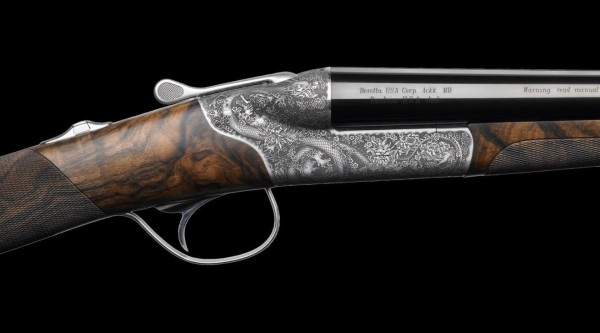
The double-barrel, with its wider view, can, however, distract the eye, especially with very high or distant birds. For such situations, the over-under is often preferred as it allows the target to stay in view without obstruction, ensuring greater accuracy in the shooting line.
Adapting the Technique to the Situation
For low or medium-height shots, such as straight pheasants or partridges up to 25 meters, the double-barrel is ideal with a smooth and quick movement. However, when facing higher or longer-range birds, the approach changes. It’s advisable to treat these shots as crossing shots, shifting the feet, lowering the opposite shoulder, and tilting the rifle to keep the target visible above the barrels.
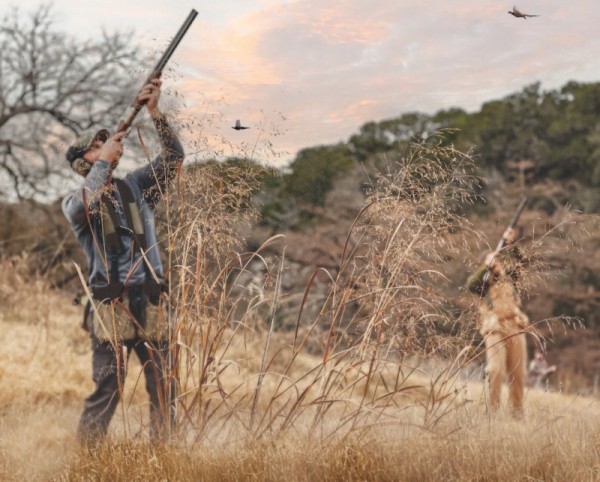
The double-barrel shines particularly in traditional low-flying hunts, such as partridges gliding over a hedge or capercaillie taking off suddenly. In these situations, the maneuverability and speed of the double-barrel surpass any other advantage.
Aesthetics and Tradition
Aesthetically, the double-barrel remains unparalleled. Its classic elegance and timeless appeal evoke images of traditional hunts, where respect for wildlife and the land blend with the art of shooting. An over-under, with its more modern and robust mechanics, may not have the same visual impact but compensates with superior performance in terms of versatility and precision.
The Right Tool for the Right Shot
Ultimately, what matters is not so much which rifle is used, but how it is used. The double-barrel offers:
- Timeless elegance
- Maneuverability in tight spaces
- Quick reloading thanks to the wide barrel openings
- Immediate selectivity with two triggers
The over-under, on the other hand, excels in:
- Better pointability thanks to the narrow visual plane
- Reduced perceived recoil
- Precision in long or complex shots
- A wide range of load options on the market
A Matter of Balance
The choice between a double-barrel and an over-under is a deeply personal decision, influenced by the hunter’s preferences, the type of hunt, and environmental conditions. Each configuration has its strengths and weaknesses, but what unites them is the ability to provide unforgettable experiences.
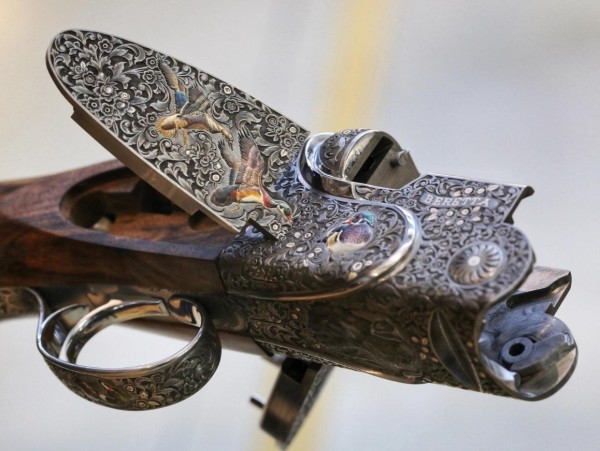
A good hunter knows how to adapt their technique to the rifle in hand, transforming every shot into a work of art. Whether it’s an elegant side-by-side or a high-performance over-under, the important thing is to respect tradition, celebrate nature, and constantly refine one’s skills. After all, at the heart of hunting, there’s always something deeper than just the shot: the unique bond between man, rifle, and game.
Masterpieces of Mechanics and Art: Holland & Holland, Chapuis, Beretta, and Benelli
When it comes to rifles, they are not just hunting tools, but true masterpieces of art and engineering. The great manufacturers have written unforgettable chapters in the history of hunting, offering models that combine tradition, innovation, and impeccable performance. Among the most renowned names, Holland & Holland, Chapuis, Beretta with its PB line, and modern Benelli over-unders represent the pinnacle of craftsmanship in hunting rifle production.
Holland & Holland: The Elegance of English Tradition
Founded in 1835, Holland & Holland embodies the essence of English tradition in luxury rifle manufacturing. Their double-barrels are famous worldwide for their classic elegance and precision. Each gun is made to measure, tailored to the size, preferences, and needs of the hunter.
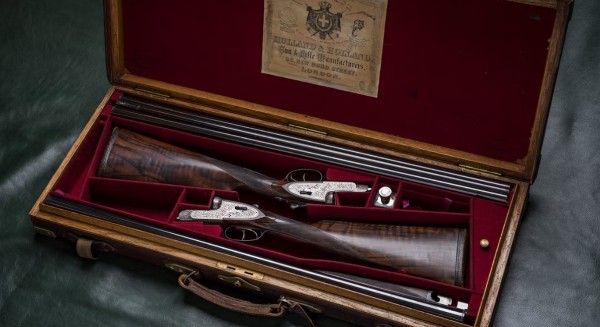
One of the most iconic models is the Royal Side-by-Side, a symbol of perfection and refinement. With its straight stock made of fine wood, hand engravings of the highest artistic level, and impeccable firing mechanisms, it represents the quintessence of the traditional double-barrel. The lightness and maneuverability of these guns make them ideal for pheasant and partridge hunting, where speed and responsiveness are essential.
Holland & Holland also stands out for its dedication to durability. Each gun is designed to be passed down from generation to generation, creating a unique bond between the hunter and the rifle. When you take hold of a Holland & Holland, you’re not just handling a firearm: you’re connecting with a history of excellence spanning nearly two centuries.
Chapuis: French Craftsmanship at the Service of Hunting
On the other side of the Channel, French manufacturer Chapuis Armes has earned a reputation for excellence with its double-barrels and over-unders. Founded in 1925, Chapuis blends traditional elegance with modern precision, offering guns appreciated by both traditional hunters and those oriented toward contemporary performance.

The Chapuis Progress model is particularly prized for its sturdiness and versatility. It’s a double-barrel distinguished by perfect balance and the ability to handle both small game and more challenging prey. Fine engravings and selected woods pay homage to tradition, while the internal mechanisms reflect the best of modern technology.
Chapuis’s strength lies in its ability to create guns that adapt to every hunting style, while maintaining an aesthetic line that celebrates French craftsmanship. Perfect for flatland hunts or forest expeditions, these rifles are reliable and captivating companions.
Beretta: Italian Tradition with a Touch of Modernity
When it comes to Beretta, we enter a world of innovation rooted in the distant year of 1526. The PB (Pietro Beretta) line represents the peak of production from this historic Italian company. These rifles, designed for demanding hunters, combine centuries-old craftsmanship with the most advanced technology.
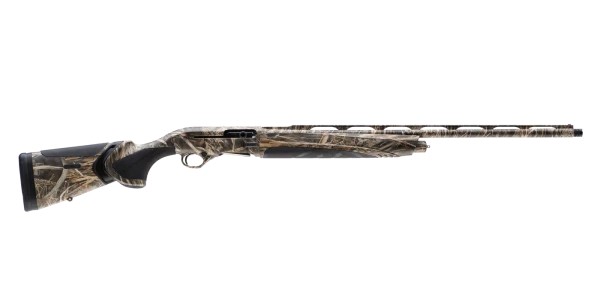
One of the most iconic models from the PB line is the SO10 EELL, an over-under that blends outstanding performance with breathtaking aesthetics. With incredibly detailed hand engravings and a stock made from the finest woods available, the SO10 EELL is considered an artwork as much as a hunting tool.
Beretta also excels in creating modern over-unders, like the 690 Field III, a versatile rifle perfect for both feather and fur hunting. With reliable mechanics and ergonomic design, it’s an ideal model for those who desire precision and durability without sacrificing Italian elegance.
Benelli: The Future of Over-Unders
Benelli, a brand synonymous with innovation and technology, has established itself as a leader in semi-automatic rifle production, but its recent foray into over-unders has proven the company’s ability to bring freshness and modernity to this traditional segment.

The Benelli 828U is a revolution in the world of over-unders. This rifle combines modern and lightweight design with innovative technical solutions, such as the Progressive Comfort system for recoil reduction and a lightweight alloy receiver that keeps the gun balanced and easy to handle. The result is an extremely versatile shotgun, perfect for both dynamic hunting and long-distance shooting.
The 828U is the epitome of what Benelli stands for: innovation at the service of the modern hunter. With simplified maintenance and exceptional reliability, this over-under shotgun is ideal for those seeking a fusion of technology and uncompromising performance.
The Right Shotgun for the Right Hunter
Whether one chooses the timeless elegance of a Holland & Holland, the versatility of a Chapuis, the Italian tradition of Beretta, or the cutting-edge innovation of Benelli, every hunter can find the shotgun that best suits their style and needs.
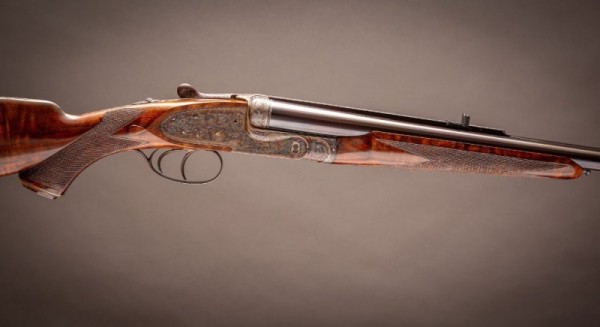
Choosing a shotgun is not just a technical decision but a personal bond that unites tradition, functionality, and passion. Every firearm tells a story, embodies a hunting philosophy, and reflects a commitment to quality. Shouldering one of these masterpieces means connecting with nature, honoring hunting traditions, and experiencing every hunt as an unforgettable journey.
In the end, the heart of hunting is not just about the perfect shot but the deep connection with the world around us – a bond that these extraordinary tools make possible.
FAQ – Side-by-Side vs Over-and-Under Shotguns: What Hunters Really Need to Know
1. What are the main differences between a side-by-side and an over-and-under shotgun in hunting use?
The difference lies in the barrel layout: side-by-side shotguns have two horizontal barrels, while over-and-under shotguns have stacked vertical barrels. This affects balance, sighting line, recoil management and the type of shooting style best suited for each. For example, over-and-unders often offer better accuracy on driven birds or sporting clays, while side-by-sides excel in fast, instinctive shots typical of rough shooting.
2. Is one type of shotgun better suited for bird hunting in Italy or Europe?
Yes. In traditional driven hunts across Tuscany, the Pyrenees, or the Scottish moors, the over-and-under is often favored for its balance and sight picture. However, side-by-sides remain iconic for walk-up hunts in the lowlands and among enthusiasts of classic European-style shooting.
3. Why do side-by-sides feel lighter in the hands?
Side-by-side shotguns are typically built with slimmer actions and lighter barrels. Their weight distribution allows for quick mounting and fast swings, ideal for tight shooting situations like thick brush or upland bird hunting.
4. Are over-and-under shotguns easier to aim for beginners?
Absolutely. With only one barrel in your line of sight, over-and-unders naturally align with your eye, offering a clearer sighting plane. This makes them more intuitive for shooters learning to track and swing on flying targets.
5. How does recoil feel between the two designs?
Over-and-unders tend to distribute recoil straight back into the shoulder, which many find more comfortable, especially with heavier loads. Side-by-sides may have more noticeable muzzle rise due to the horizontal layout, which can be more challenging during fast follow-up shots.
6. Which shotgun offers better versatility in different hunting contexts?
The over-and-under usually takes the lead here. Thanks to its controlled balance and superior target tracking, it adapts well from clays to migratory birds to wild boar battues. That said, many hunters still carry side-by-sides for specific hunts where quick handling and tradition matter most.
7. Are side-by-sides outdated for modern hunting?
Not at all. While less common in competition circuits, side-by-sides remain beloved for their charm, lightweight feel, and heritage. Many experienced hunters still choose them for upland game and for the sheer pleasure of carrying a timeless classic in the field.
8. Is one shotgun type more durable than the other for rugged conditions?
Both can be built to last, but over-and-unders usually feature stronger locking systems and tighter tolerances, making them better suited for high-volume shooting like driven game hunts or clay competitions. That said, a well-maintained side-by-side can last generations.
9. Do over-and-unders offer more choke options or barrel control?
Generally, yes. Over-and-unders often come with interchangeable choke systems and selectable triggers, giving hunters better control over shot patterns and order of fire. Some modern side-by-sides now offer similar features, but they’re less common.
10. Which shotgun is more comfortable for smaller or older shooters?
Over-and-unders, with their balanced recoil and customizable stocks, often provide better shooting comfort for those with smaller frames or shoulder issues. A good gunsmith can also adjust stock length and pitch to match the shooter’s build for either type.
11. How important is the visual line (rib) for performance?
Extremely important. The single rib on an over-and-under aligns naturally with your dominant eye, enhancing precision and tracking. Side-by-sides have a wider sight plane that can lead to inconsistent aim if not properly mounted or practiced.
12. Which type is better for fast shooting in tight woodland?
Side-by-sides are unbeatable in this context. Their shorter barrels and quicker swing dynamics make them ideal for snap shooting in dense woods or during sudden flushes of pheasant and partridge.
13. Are side-by-sides more difficult to master for new shooters?
Yes and no. While the wide sighting plane of side-by-sides can take some getting used to, experienced shooters often find them intuitive for quick, natural pointing once accustomed. Over-and-unders, however, remain the preferred choice for most new hunters.
14. What’s the difference in price between the two shotgun types?
There’s no fixed rule. Handcrafted side-by-sides can be far more expensive than a mid-range over-and-under. Yet there are also very accessible entry-level options in both styles. The final price often reflects engraving, origin, balance, barrel regulation, and heritage.
15. Do over-and-unders offer better accuracy at longer ranges?
Yes. Their consistent point of aim and tighter chokes allow for greater accuracy on targets at distance, making them a favorite in sporting clays and high bird shoots.
16. Which is easier to clean and maintain?
Both are fairly straightforward to maintain, but over-and-unders often have simpler mechanics when it comes to trigger and safety systems. That said, side-by-sides have fewer moving parts in some configurations, depending on the lock type.
17. Can both shotgun types be used for hunting boar in Italy or Eastern Europe?
Certainly. For battue-style driven hunts in regions like Piedmont or Bulgaria, many hunters choose over-and-unders in slug configuration or double rifles. But classicists often prefer powerful side-by-sides with open chokes for close-range stopping power.
18. Do any shotgun makers specialize in high-end side-by-side models?
Yes, legendary European gunmakers like Beretta, Purdey, and Holland & Holland continue to produce exquisite side-by-sides, often custom-built and beautifully engraved, true collector’s items that remain practical for hunting.
19. Are there safety differences between the two?
Not really. Both feature mechanical or automatic safeties and barrel selectors. The key lies in the shooter’s experience and how well the gun is maintained. Always treat both types with the same level of respect and caution.
20. What’s the best way to decide which shotgun is right for me?
Try both. Visit a Montefeltro shooting ground or test event, shoulder both models, and shoot a few clays. Your shoulder, eye, and instinct will guide you toward the shotgun that becomes an extension of your hunting soul.

